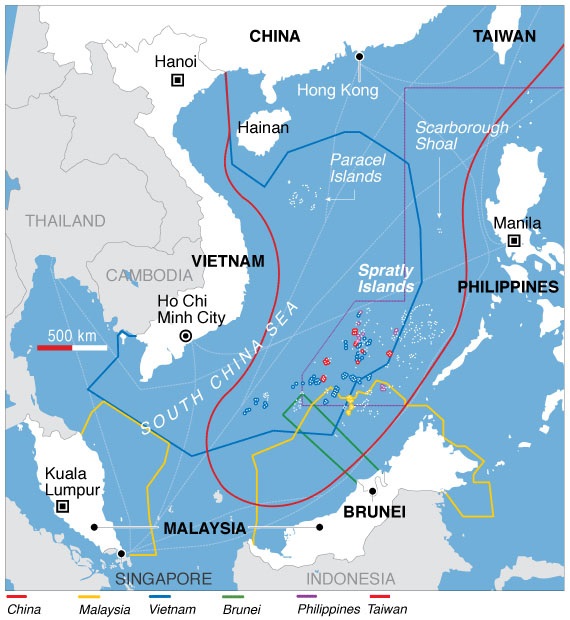Rising South China Sea Tensions and Concerns for Europe
China’s long-running territorial disputes regarding Taiwan and the South China Sea have become two of Asia’s biggest flashpoints. How to keep them from igniting into military conflict? This Clingendael Spectator series looks beyond the headlines of these flashpoints. In this second episode, Vera Kranenburg and Nick Bontenbal analyse the mutually exclusive claims in the South China Sea and explain why Europe should heed the escalating tensions.
On 5 August, the Philippines accused the Chinese coast guard of dangerously and illegally firing a water cannon at Philippine vessels on a resupply mission to Second Thomas Shoal in the Spratly Islands within the South China Sea.1 Several countries including the United States, Japan, Australia, and Germany have criticised these Chinese actions.2
It was not until 22 August that the Philippines managed to successfully carry out this resupply operation. According to the Chinese coast guard, transporting construction materials to the disputed shoal is “illegal” but they “made temporary arrangements for Manila […] to deliver food and necessities on humanitarian grounds”.3 The Philippine coast guard dismissed this explanation, stating that Chinese vessels once again interfered with their mission.4
Events like these, including near-collisions and stand-offs, frequently take place in the South China Sea, illustrating that the region is an area of potential conflict. These incidents are a direct consequence of the territorial disputes in the South China Sea, where China, Taiwan, Vietnam, Malaysia, Indonesia, the Philippines, and Brunei all have their own – often overlapping – territorial claims.
This seemingly regional dispute in Asia should concern Europe because of the highly strategic value of the South China Sea
Although the disputes in the South China Sea do not make headlines quite as often as a potential conflict in the Taiwan Strait,5 the current situation – with a high frequency of incidents – is more volatile than it has been in a long time. China is increasing its military power and efforts to assert influence in the area, while the counterpressure from some of the sea’s surrounding countries such as Vietnam and the Philippines is also on the rise, along with increased involvement from the United States. This mounting pressure from multiple sides, combined with the presence of the US as a powerful external actor, further raises the risk of these disputes escalating into conflict.
This seemingly regional dispute in Asia should concern Europe because of the highly strategic value of the South China Sea. If a territorial dispute in the South China Sea were to escalate into open conflict, the impact on not only the surrounding nations, but also on the world economy would be enormous. Given that approximately 22 to 30 per cent of the entire global trade volume – including Asian-European trade – passes through the South China Sea, any disruption could have far-reaching implications.6 Recognising this, the European Council recently emphasised the strategic significance of the South China Sea “for regional and global prosperity and security”.7
Key to grasping the current dynamics in the South China Sea is understanding how Vietnam, Malaysia, and the Philippines – the three Southeast Asian states with the largest overlapping claims with China – respond to the increase of Chinese military power and activities to claim sovereignty over the sea.
Territorial claims: a high-stakes issue
Based on what it calls “historic rights”,8
China claims a large area in the South China Sea, of which the demarcation line is known as the ‘nine-dash line’.9
This claim covers most of the South China Sea and overlaps with several territorial claims and Exclusive Economic Zone (EEZ) claims of surrounding countries, both of which are based on the United Nations Convention on the Law of the Sea (UNCLOS).

EEZs are areas where a nation holds the right to exploit natural resources. Consequently, conflicting territorial claims do not only have political implications, but can also have a significant economic impact. Due to the rich fishing grounds and deposits of other natural resources, such as gas and oil,10 the South China Sea is a critical area for the utilisation of EEZs, underlining the economic aspects of the dispute as a high-stakes issue.
In 2016, the Permanent Court of Arbitration (PCA) in The Hague ruled that there is “no legal basis for China to claim historic rights to resources within the sea areas falling within the ‘nine-dash line’”.11 China’s response stated that the Court did not have the authority to rule on these matters.12
To limit tensions, China and ASEAN – the intergovernmental association of which all Southeast Asian claimant states are members – signed the (non-binding) Declaration on the Conduct of Parties in the South China Sea, in which the signatories vowed to uphold peace in the area.13 Although this could potentially have been a step towards a peaceful solution of the disputes, there has been very limited progress towards a binding code of conduct ever since.
Chinese activities
Despite the 2016 ruling by the PCA, China has employed a variety of tactics to pursue its interests in the South China Sea. Three main activities have been at the forefront of China’s actions in the area: land reclamation, coast guard or military patrols, and the presence of militias.
1. Land reclamation
Perhaps the most well-known way in which China has tried to reinforce its claim over the South China Sea is through building and enlarging the rocks, shoals, and low-tide elevations over which it has established control. Although the Chinese government officially denies the existence of such land reclamation projects,14
satellite images have shown that large-scale land reclamation operations have been taking place since 2013. The Chinese military has also significantly expanded its presence and infrastructure on these features, in order to increase its ability to effectively project its military power in the area.15
2. Coast guard or military patrols
In response to what it sees as intrusions by warships of other nations, China has frequently scrambled fighter jets to chase away warships of other countries from the claimed area in the South China Sea.16
One notable type of ‘intrusion’ is the presence of foreign navies in the sea, including the so-called Freedom of Navigation Operations (FONOPs) carried out by the US Navy.17
Besides this, the Chinese Coast Guard is frequently deployed to fend off what are considered trespassers on Chinese territory.
3. Chinese militias
In addition to the Chinese Coast Guard, Chinese militias (often under local government control) are also active in the area, mainly using converted fishing boats. The militia members, posing as fishermen and sometimes cooperating with them, are often involved in attacking or chasing away fishing boats, gas exploration vessels, or other nations’ navy ships.18
Responses by Southeast Asian states
How do other claimant states respond to these activities?
To a certain degree, Southeast Asian states with their own claims in the South China Sea all face the same dilemma. On the one hand, China is an extremely important economic actor on both a regional and global level. However, on the other hand, they perceive China as a potential military threat.
To a certain degree, Southeast Asian states with their own claims in the South China Sea all face the same dilemma
Due to China’s assertive behaviour in the South China Sea, many of the claimant states worry about an encroaching China and thus take measures to defend their interests. These measures range from diplomatic engagement and downplaying of tensions to direct confrontation. Several factors influence the approach these various claimant states adopt towards Chinese activities in the South China Sea.
Malaysia
The Malaysian government has made the calculation that maintaining a good relationship – which is mostly focused on economic cooperation – rather than directly responding to incidents in the South China Sea is in the country’s best interest. For this reason, the country has ordered its vessels to deal with Chinese incursions by observing them from a safe distance. Despite incursions, Chinese cyberattacks,19
and attempts to keep Malaysian state company Petronas from exploiting resources in the South China Sea.20
Although this approach limits Malaysia’s freedom to act in the area it claims as sovereign territory, it works well in terms of preventing escalation of the territorial dispute. The Malaysian ruling elite adopted this strategy because they do not perceive China as a significant threat, afraid it will become a self-fulfilling prophecy. Therefore, they avoid engaging in an “action-reaction spiral” and instead “make its relationship with Beijing indispensable”.21
Vietnam
In the Vietnamese relationship with China history plays a more important role compared to Malaysia’s.22
The 120 Vietnamese fishermen that have died over the last thirty years partly as a result of attacks by Chinese vessels are of importance here as well.23
Vietnam has therefore adopted a more forthright approach to Chinese actions in the South China Sea. Remarkable is how Vietnam – although not on the same scale as China – has also conducted island expansion operations, adding around 170 hectares of new land to the roughly 50 features it controls.24
Beyond territorial claims, there have also been confrontations between Chinese and Vietnamese actors. Numerous reported incidents involve Vietnamese fishermen being attacked or harassed by the Chinese Coast Guard,25 and stand-offs between Chinese and Vietnamese vessels in the Vietnamese EEZ frequently occur.26
In addition to physical altercations, Vietnam has also sought to address the situation diplomatically, with officials threatening to initiate an international legal procedure against China.27 However, these threats have not gone beyond mere rhetoric.
The frequent physical confrontations contribute to China-Vietnam relations being among the more volatile bilateral relationships in the South China Sea. Vietnam has also built and expanded a maritime militia of its own28 and enhanced its military capabilities,29 further increasing the chances of incidents and the risks that come with them.
The Philippines
The Philippines is adopting an increasingly direct approach in its dealings with China in the South China Sea. Since March 2023, the country has started publicising Chinese actions in the region by releasing videos of incidents involving the two states’ coast guard ships.30
In April, the Philippines took the next step in its new strategy by taking journalists onboard a ship that witnessed a near-collision between a Chinese and Philippine Coast Guard ship. This move led to Chinese criticism.31
In June, the Philippines took a step further in its new strategy by inviting tourists to the Spratly Islands it controls. With these tours the country aims to strengthen its territorial claim and to enable tourists to observe the behaviour of nearby Chinese ships.32
In the case of the Philippines, domestic political outlook matters a lot when it comes to its relationship with China and its alliance with the United States
In previous years, the Philippines already publicly protested Chinese actions, including voicing diplomatic protest when Chinese vessels were present in areas claimed by the Philippines. In 2021, the country already intensified patrols in the South China Sea “beyond anything seen in years”, according to the Asia Maritime Transparency Initiative.33 In February 2023, the state’s coast guard chief said that it had again “stepped up its presence”, including deployment of vessels and conducting overflights.34
In the case of the Philippines, domestic political outlook matters a lot when it comes to its relationship with China and its alliance with the United States.35 Current Philippine president Ferdinand Marcos Jr. has taken a more outspoken stance on Chinese claims and actions in the South China than his predecessor.36 Marcos Jr.’s administration has also stepped up the country’s engagement with the US – and others, such as Australia and Japan – in the region.37
In April 2023, the Philippines announced that the US would gain access to four additional Philippine military bases.38
The US is eager to increase its influence in Asia as a way to counter its primary geopolitical rival, China, including by deepening cooperation with its allies in the region, like the Philippines.
The cost of neglecting the South China Sea disputes
Understanding the different approaches claimant states are taking towards China in the South China Sea is key to comprehend the current dynamics in the area. Yet, the question remains: why should Europe be concerned about a seemingly regional dispute?
Firstly, this potential flashpoint could profoundly affect the global economy, as more than 22 to 30 per cent of international trade passes through the region. The potential escalation of an incident in the South China Sea could impede European trade, as approximately 40 per cent of the EU’s foreign trade runs through this area.39 Thus, any conflict disrupting these flows would have a severe negative impact.
Secondly, driven by geopolitical motives, several European countries – such as the Netherlands, Germany, France and Italy – have in recent years sent their own military vessels to the region and have committed to doing so more frequently in the coming years.40 This amplified European military presence in the South China Sea heightens the risk of European nations becoming – possibly unintentionally – directly involved in an escalation of the dispute.
Europe should (continue to) pay attention and prepare an apt response to a potential escalation in the region
Thirdly, as a major military power actively engaged in the region, the United States plays a crucial role in the geopolitical dynamics of the South China Sea. This is particularly crucial for Southeast Asian claimant nations, like the Philippines, aiming to counterbalance China’s activities in the area. The volatile situation in the South China Sea is also connected to the Taiwan Strait flashpoint, further amplifying the importance for the US.41 If the United States were to be directly involved in a conflict between, for example, the Philippines and China within the South China Sea, it would also reverberate across American security commitments in Europe. Moreover, the US might reach out to European allies for support, both economically and military, drawing them into the complex South China Sea dynamics.
In conclusion, recent months have underscored the volatility of the disputes in the South China Sea, with a high degree of activity and skirmishes. Europe should therefore (continue to) pay attention and prepare an apt response to a potential escalation in the region. When assessing risks in East and Southeast Asia that could have an impact on Europe, focusing solely on a potential conflict around Taiwan would overlook a key flashpoint, which, in many ways, is even more complex.
- 1‘Philippines accuses China of water cannon attack in Spratly Islands, The Guardian, 6 August 2023.
- 2Brad Lendon and Kathleen Magramo, 'International backlash grows after Chinese vessel fires water cannon on Philippine boats,’ CNN, 7 August 2023.
- 3Ella Cao and Liz Lee, ‘China firmly opposes Philippines transporting construction materials to grounded warship’, Reuters, 22 August 2023.
- 4‘China lying about allowing resupply mission to Ayungin: Coast Guard’, ABS-CBN News, 23 August 2023.
- 5Xiaoxue Martin, ‘Why the European Inconsistency on Taiwan is a Concern’, Clingendael Spectator, 23 May 2023.
- 6David Uren, ‘Southeast Asia will take a major economic hit if shipping is blocked in the South China Sea’, ASPI Strategist, 8 December 2020.
- 7European Council, ‘European Council conclusions on China’, 30 June 2023.
- 8Keyuan Zou, ‘Historic Rights in the South China Sea Arbitration Case: A Preliminary Reflection’, Asia-Pacific Journal of Ocean Law and Policy, December 2016.
- 9The ‘nine-dash line’ is named after the dashes drawn on the map to show the area would be Chinese. The line is dashed because it represents a maritime boundary (which is less fixed than a continental boundary). For more information on the development of the concept ‘nine-dash line’, see: Hannah Beech, ‘Just Where Exactly Did China Get the South China Sea Nine-Dash Line From?’, Time, 19 July 2016.
- 10Friso Dubbelboer, ‘UNCLOS under Pressure: Law of the Jungle or Law of the Sea?’, Clingendael Spectator, 28 July 2020.
- 11‘Press Release: The South China Sea Arbitration (the Republic of the Philippines v. the People’s Republic of China)’, Permanent Court of Arbitration, 12 July 2016.
- 12‘China challenges Arbitral Tribunal’s authority’, Xinhua, 14 July 2016.
- 13‘Declaration on the Conduct of Parties in the South China Sea’, Association of Southeast Asian Nations, 14 May 2012.
- 14‘China says 'no such thing' as man-made islands in South China Sea’, Reuters, 30 March 2017.
- 15‘Chinese Power Projection Capabilites in the South China Sea’, Asia Maritime Transparency Initiative, 20 March 2022.
- 16Helen Davidson, ‘US Navy rejects China claim that warship ‘illegally’ entered part of South China Sea’, The Guardian, 23 March 2023.
- 17‘7th Fleet Cruiser Conducts Freedom of Navigation Operation in South China Sea’, US 7th Fleet Public Affairs, 28 November 2022.
- 18An example of this involvement was the case when Chinese fishermen militia were used to monitor ASEAN-India joint navy drills in May 2023. See: ‘South China Sea: Asean-India drills stalked by Chinese maritime militia, sources say’, South China Morning Post, 9 May 2023.
- 19Sribala Subramanian, ‘Phishing in the South China Sea’, The Diplomat, 3 April 2023.
- 20Amy Chew, ‘Malaysia’s energy needs face Chinese pushback in South China Sea’, Al Jazeera, 25 April 2023.
- 21Emirza Adi Syailendra, ‘Why don’t Malaysian Policymakers view China as a threat?’, The Diplomat, 24 February 2023.
- 22Think, for example, about the two-week invasion of Northern Vietnam by the Chinese military in 1979.
- 23‘Beaten and robbed: Vietnamese fisherman recounts China attacks’, The Straits Times, 5 October 2022.
- 24David Brunnstrom, ‘Vietnam in big push to expand South China Sea Outpost – U.S. Think Tank’, Reuters, 20 March 2022.
- 25‘Vietnam Fisherman Recounts Attacks China by China Coast Guard in South China Sea’, South China Morning Post, 14 October 2022.
- 26Sebastian Strangio, ‘Vietnamese, Chinese Vessels in Close South China Sea Encounter’, The Diplomat, 28 March 2023.
- 27Peter A. Dutton, ‘Vietnam Threatens China with Litigation over the South China Sea’, Lawfare, 27 July 2020.
- 28Khac Giang Nguyen, ‘The Vietnamese Maritime Militia: Myths and Realities’, RSIS, 21 July 2022.
- 29Arming Vietnam: Widened International-security Relations in Support of Military-capability Development, International Institute for Strategic Studies, 20 March 2023.
- 30In March 2023, the Philippines launched a new strategy in the South China Sea: publicising Chinese actions. In February 2023, an incident between the Chinese and Philippine coast guards occurred, in which the Chinese Coast Guard allegedly used a military-grade laser to temporarily blind a crew member aboard a Philippine ship. (See: Rebecca Ratcliffe, ‘Chinese ship accused of using ‘military-grade laser’ against Philippine vessel’, The Guardian, 13 February 2023.) The Philippine Coast Guard published a video of the laser-incident. (See: ‘Philippines launches strategy of publicising Chinese actions in South China Sea’, South China Morning Post, 8 March 2023.) In April, a near-collision between a Chinese and a Philippine vessel took place. (See: ‘Chinese, Philippine vessels near-crash’, AFP News Agency on Twitter, 28 April 2023.) A video of the event was published by journalists invited to be present on a Philippine ship nearby, signalling a next step in the Philippine strategy to publicly showcase Chinese actions in the South China Sea.
- 31The Chinese foreign ministry spokesperson reiterated the Chinese claim over these islands and waters, qualifying the presence of journalists as a “premeditated provocation designed to deliberately create a friction, be blamed on China and hyped up in the media”. See: ‘Foreign Ministry Spokesperson Mao Ning’s Regular Press Conference’, Ministry of Foreign Affairs of the People’s Republic of China, 28 April 2023.
- 32‘Eilandjepik in betwiste wateren, op 'vakantie' in de Zuid-Chinese zee’, NOS Nieuws, 3 July 2023.
- 33‘Out in Force: Philippine South China Sea are way up’, Asia Maritime Transparency Initiative, 26 May 2021.
- 34‘Out in Force: Philippine South China Sea are way up’, Asia Maritime Transparency Initiative, 26 May 2021.
- 35Richard Javad Heydarian, ‘Marcos Jr’s coalition ripping apart on US-China lines’, Asia Times, 4 July 2023.
- 36Former president Rodrigo Duterte made a pro-China pivot, viewed China as an economic opportunity, and used Chinese financing for his own domestic political gain. (See: Alvin Camba, ‘How Duterte Strong-Armed Chinese Dam-Builders But Weakened Philippine Institutions’, Carnegie Endowment, 15 July 2021.) Current president Marcos Jr. instead views the Philippines’ alliance with the US as the way to protect the country and wishes to challenge Beijing’s claims, therefore expanding the alliance and allowing US troops access to more Filipino bases.
- 37In the media, joint maritime patrols with the US, as well as potential joint patrols with Australia and Japan, received a lot of attention.
- 38Three are located on Luzon, in the north of the Philippines, near Taiwan, and one on Balabac, near the Spratly Islands in the South China Sea.
- 39Sophie Boisseau du Rocher, the EU’s South China Sea Challenge, The Diplomat, 1 February 2021.
- 40In 2021, a Dutch frigate was part of a UK Carrier Strike Group that visited the region. In 2022, Dutch Defence Minister Kajsa Ollongren announced that the Netherlands aims to send a frigate every two years. Germany, for the first time in two decades, also sent a vessel to the region in 2021 and plans to deploy two warships in 2024. France’s contribution came in June 2023 to “support liberty of navigation”. Furthermore, the Italian Navy intends to send an aircraft carrier with its battle group to the South China Sea in 2023 or 2024.
- 41The recent access granted to the US to make use of Philippine bases highlights this, as these bases are strategically located near Taiwan and the contested Spratly Islands in the South China Sea.









0 Reacties
Reactie toevoegen